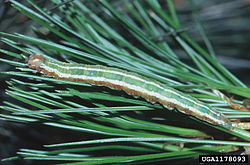| Zale helata | |
|---|---|
 | |
| Northern variant | |
| Scientific classification | |
| Domain: | Eukaryota |
| Kingdom: | Animalia |
| Phylum: | Arthropoda |
| Class: | Insecta |
| Order: | Lepidoptera |
| Superfamily: | Noctuoidea |
| Family: | Erebidae |
| Genus: | Zale |
| Species: | Z. helata |
| Binomial name | |
| Zale helata McDunnough, 1943 | |
| Synonyms | |
| |
Zale helata, the brown-spotted zale, is a moth of the family Noctuidae. The species was first described by James Halliday McDunnough in 1943. It is found in barrens and pine woodlands from Manitoba to Maine, south to northern Alabama and Texas.
The wingspan is 35–41 mm. Adults are on wing from May to June. There is one generation per year.